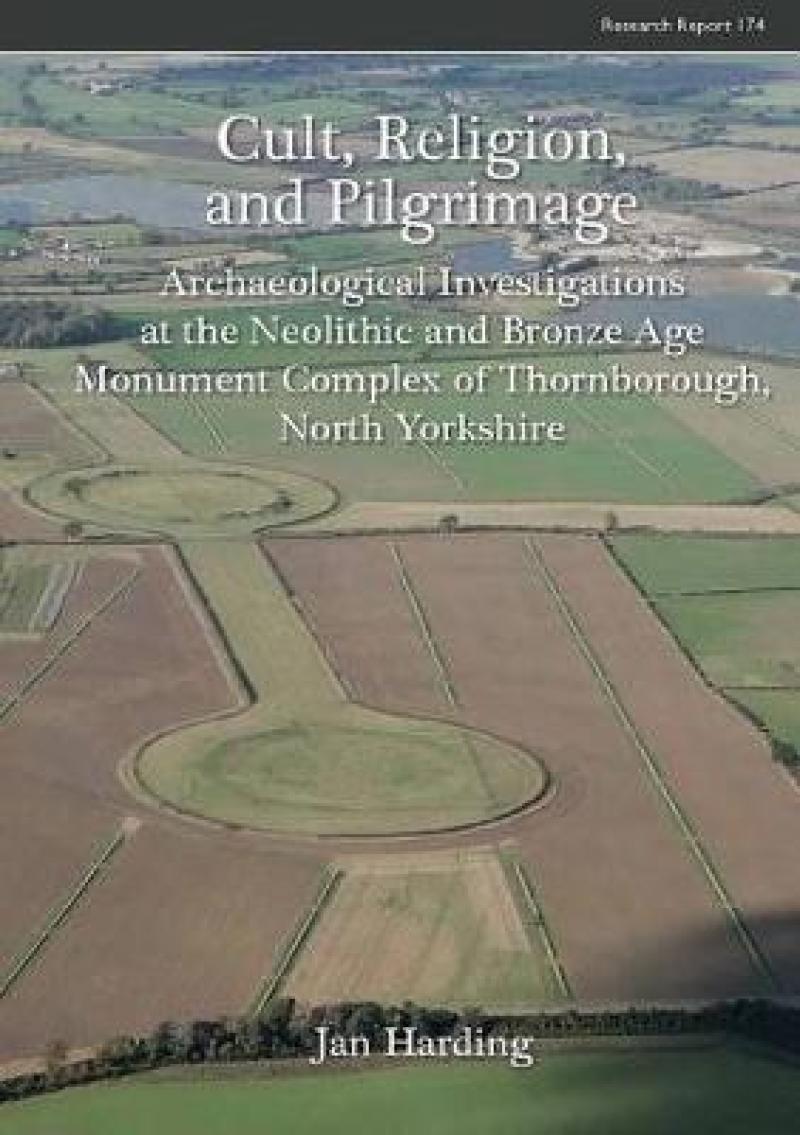The three large henges found adjacent to the village of Thornborough, near Ripon in North Yorkshire, lie at the heart of one of the most important Neolithic landscapes in the British Isles While the henges were first recorded in the eighteenth century, recent fieldwork has shown them to be part of a much larger ‘sacred landscape’ of the later Neolithic and Bronze Age which includes barrows, pit alignments and a cursus. Surrounding fields have yielded a rich collection of prehistoric flint artefacts. While the henges have all been damaged, either by agriculture or quarrying, they remain major upstanding features in the modern landscape.
This volume considers first the history of investigations and changing attitudes towards the monuments before describing the detailed geophysical surveys, excavations and fieldwalking programmes that have been carried out across this landscape in the past twenty years.
The author concludes that this was an intensely religious landscape, situated on an important routeway across the Pennines. He considers how people, both those who lived locally and those who travelled long distances to visit the site as a place of pilgrimage, would have experienced and interacted with the monuments
Les mer
The three large henges found adjacent to the village of Thornborough, near Ripon in North Yorkshire, lie at the heart of one of the most important Neolithic landscapes in the British Isles While the henges were first recorded in the eighteenth century, recent fieldwork has shown them to be part of a much larger ‘sacred landscape’ of the later ...
Les mer
1 Interpreting monument complexes 1.1 Introduction 1.2 Monuments as socio-political narratives 1.3 Monuments as sacred architecture 1.4 Conclusion 2 Creating narratives 2.1 Introduction 2.2 Early documentation, place-name evidence, and folklore 2.3 Enclosure and antiquarianism 2.4 The archaeology of a 20th-century mixed economic landscape 2.5 Research agendas and projects 1994 - 2004 2.6 A contested early 21st-century landscape 3 Physicality of presence 3.1 Introduction 3.2 The landscape setting 3.3 The monument complex (Jan Harding and Benjamin Johnson) 3.3.1 Cursus (Jan Harding, Benjamin Johnson, and Alan Biggins) 3.3.2 Henges (Jan Harding, Benjamin Johnson, Alan Biggins, Ed Dennison, and Armin Schmidt) 3.3.3 Round barrows and ring-ditches (Jan Harding, Benjamin Johnson, and Alan Biggins) 3.3.4 Other monuments (Jan Harding and Benjamin Johnson) 3.4 Conclusion 4 Acts of monument construction 4.1 Introduction 4.2 Triple-ditched round barrow (Jan Harding, Benjamin Johnson, Sarah Groves, and Simon Mays) 4.2.1 Introduction 4.2.2 Excavation results 4.2.3 Discussion 4.3 Gypsum pits (Jan Harding and Benjamin Johnson) 4.3.1 Introduction 4.3.2 Excavation results 4.3.3 Discussion 4.4 Oval enclosure (Jan Harding and Joshua Pollard) 4.4.1 Introduction 4.4.2 Excavation results 4.4.3 Discussion 4.5 Central henge and cursus (Jan Harding and Blaise Vyner) 4.5.1 Introduction 4.5.2 Excavation results 4.5.3 Discussion 4.6 Southern henge 4.6.1 Introduction 4.6.2 Excavation of outer ditch (Jan Harding and Blaise Vyner) 4.6.3 Excavation of inner ditch (Jan Harding, Robert Johnston, Blaise Vyner, and Lindsay Allason-Jones) 4.6.4 Discussion 4.7 Double pit alignment (Jan Harding, Benjamin Johnson, Blaise Vyner, and Peter Makey) 4.7.1 Introduction 4.7.2 Excavation results 4.7.3 Discussion 4.8 Three Hills round barrow (Jan Harding and Benjamin Johnson) 4.8.1 Introduction 4.8.2 Excavation results 4.8.3 Discussion 4.9 Themes in the development of the monument complex 5 Experiencing the landscape 5.1 General issues 5.2 Widespaced fieldwalking (Jan Harding and Benjamin Johnson) 5.2.1 Introduction 5.2.2 Lithic distribution and raw material use 5.2.3 Chronological and occupational variability 5.3 Geophysical prospection, total collection, and test-pitting (Jan Harding and Benjamin Johnson) 5.3.1 Introduction 5.3.2 Lithic scatters and post-depositional factors 5.3.3 Lithic deposition and use 5.3.4 Conclusion 5.4 The landscape of the Mesolithic and earlier to middle Neolithic 5.5 The later Neolithic and Bronze Age landscape 6 Pathways to purity 6.1 Introduction 6.2 Rivers, routes, and exchange 6.3 Water, gypsum, and the sky 6.4 Cult, pilgrimage, and social identity
Les mer
Produktdetaljer
ISBN
9781902771977
Publisert
2013-09-30
Utgiver
Council for British Archaeology
Aldersnivå
G, 01
Språk
Product language
Engelsk
Format
Product format
Heftet
Antall sider
260
Forfatter
